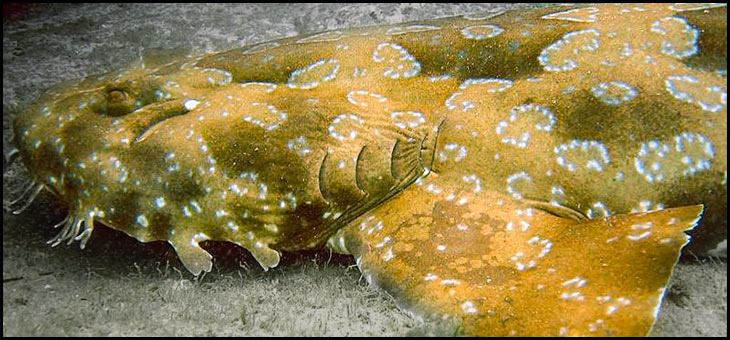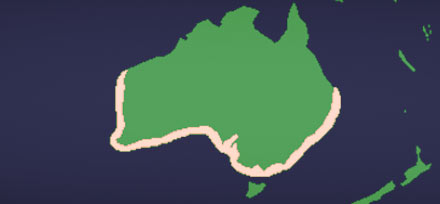Spotted Wobbegong Shark: The Camouflage Master
Orectolobus maculatus
So, you think you know sharks, do you? They’re fast, agile, fish-eating, swimming machines, right? Think again. Let me introduce you to the spotted wobbegong shark (Orectolobus maculatus) and the rest of its wobbegong comrades. It’ll turn everything you thought you knew about sharks on its head.
What do wobbegong sharks look like?
The first thing you’ll notice about a wobbegong shark is that, well…it doesn’t really look like a typical shark. In fact, it looks more like a poofy, shaggy rug than a streamlined shark—hence the other common name of this group of predators, “carpet sharks.”

Wobbegongs lie still on the bottom of reefs and shallow waters, just like certain types of flat fish such as halibut and flounder. They have plenty of camouflage to help them out, too. They have a splotched, patterned back that blends in with the reef. They also have numerous shaggy, beard-like projections around their mouth, like the famous ghillie suits of military snipers. Finally, they have tiny vertical fins (dorsal and caudal fins) that help them keep a low profile.
The wobbegong also has a H-U-G-E head. It’s actually wider across than it is long! Remember this wide head; it’ll be an important factor later.
There are many species of wobbegong shark in addition to the spotted wobbegong. They generally look alike as well, and it can be difficult to tell them apart. In many cases, the location or the size of the shark is the determining factor in species identification.
This brings up an interesting question: if you have a small wobbegong, is it actually a smaller species, or just a juvenile version of a larger wobbegong? This question has baffled experts, but thanks to DNA sequencing and other new technologies, we now know that there are 11 other wobbegong species in addition to the spotted wobbegong:
- Eucrossorhinus dasypogon – tasselled wobbegong
- Orectolobus floridus – floral banded wobbegong
- Orectolobus halei – gulf or banded wobbegong
- Orectolobus hutchinsi – western wobbegong
- Orectolobus japonicus – Japanese wobbegong
- Orectolobus leptolineatus – Indonesian wobbegong
- Orectolobus ornatus – ornate wobbegong
- Orectolobus parvimaculatus – dwarf spotted wobbegong
- Orectolobus reticulatus – network wobbegong
- Orectolobus wardi – northern wobbegong
- Sutorectus tentaculatus – cobbler wobbegong
Where do wobbegong sharks live?
While the name “wobbegong” might sound similar to Garrison Keillor’s fictional Minnesota town of Lake Wobegon, the two couldn’t be more different.
Wobbegongs (wah-buh-gongs) live in the Pacific and Indian oceans and have a very narrow range at that. The spotted wobbegong in particular is more common around Australian waters. Indonesian wobbegongs live in Indonesian waters, and Japanese wobbbegongs live in…you guessed it, Japanese waters.
Unlike a lot of other sharks that prefer cruising the open ocean, the wobbegong is more of a homebody. You might even call it a couch-potato shark. They usually pick a spot and plant themselves down, sometimes not moving for many hours at a time. In order to stay alive while stationary, they actually pump water over their gills with their cheek muscles to keep their blood oxygenated (since they aren’t moving around like most sharks do).
Wobbegongs also prefer shallow water, and they love reefs with all their nooks and crannies to hide in and hunt. Speaking of hunting…
What do wobbegong sharks eat?
Remember those big mouths that I told you to remember? Those come into key play here because a wobbegong will basically eat anything and everything moving that will fit into its mouth—and sometimes even things that don’t.
If they can’t fit something inside of their mouths, they’ll follow a trick similar to what wolves or bulldogs do. They’ll clamp down on the prey and simply hold it there until it does from exhaustion or suffocation (or drowning, in this case).
This behavior sometimes gets them into trouble with people. Wobbegongs won’t actively seek out people to hunt, but they’re sharks, and sometimes they make mistakes. Maybe a tasty-looking fish fin swimming past happens to be attached to a human leg: an unfortunate mistake for both the shark and the human.
It can be difficult to get wobbegong sharks off of you if they do clamp down, but it can be done. In fact, of 32 recorded wobbegong attacks, none were fatal.
Most of the time wobbegongs are content with simply sitting in place and letting prey come to them, although sometimes they will also actively hunt and move around. This is where some of the wobbegong’s special adaptations come into play. Their shaggy bearded projections will act like lures to draw in prey closer.
Once within reach, the wobbegongs suddenly take action. They’ll snap open their jaws, creating a huge suction draw that’ll suck in any nearby prey. It’s quite impressive to see!
Are wobbegong sharks in trouble?
Sometimes it seems like most stories of shark conservation are like witnessing the dying throes of a species. Luckily, the wobbegong’s story is a successful one that that we can learn from.
Wobbegongs have a good capacity to keep their population numbers up. They breed once every three years or so, and the viviparious (live-bearing) females can give birth to a staggering 21-37 pups per litter! (Just imagine if humans could do that…)
Wobbegongs don’t have a lot of commercial value. While you can find wobbegong on the menu in some local Australian fish n’ chip shops, they aren’t as widely eaten as some other sharks like porbeagles and mako sharks.
Wobbegongs used to be fished with very little regulation in Australia. However, after a 2007 report showed that the wobbegong population was decreasing, the government clamped down. They tightened up regulations for the commercial and recreational fishing industries in 2008. Since then it appears that the wobbegong population has been increasing. As long as we keep an eye on these shark populations and react if they appear to be going downhill, this is one shark story that will have a happy ending.
Related Topics
So, you think you know sharks, do you? They’re fast, agile, fish-eating, swimming machines, right? Think again. Let me introduce you to the spotted wobbegong shark (Orectolobus maculatus) and the rest of its wobbegong comrades. It’ll turn everything you thought you knew about sharks on its head.
What do wobbegong sharks look like?
The first thing you’ll notice about a wobbegong shark is that, well…it doesn’t really look like a typical shark. In fact, it looks more like a poofy, shaggy rug than a streamlined shark—hence the other common name of this group of predators, “carpet sharks.”

Wobbegongs lie still on the bottom of reefs and shallow waters, just like certain types of flat fish such as halibut and flounder. They have plenty of camouflage to help them out, too. They have a splotched, patterned back that blends in with the reef. They also have numerous shaggy, beard-like projections around their mouth, like the famous ghillie suits of military snipers. Finally, they have tiny vertical fins (dorsal and caudal fins) that help them keep a low profile.
The wobbegong also has a H-U-G-E head. It’s actually wider across than it is long! Remember this wide head; it’ll be an important factor later.
There are many species of wobbegong shark in addition to the spotted wobbegong. They generally look alike as well, and it can be difficult to tell them apart. In many cases, the location or the size of the shark is the determining factor in species identification.
This brings up an interesting question: if you have a small wobbegong, is it actually a smaller species, or just a juvenile version of a larger wobbegong? This question has baffled experts, but thanks to DNA sequencing and other new technologies, we now know that there are 11 other wobbegong species in addition to the spotted wobbegong:
- Eucrossorhinus dasypogon – tasselled wobbegong
- Orectolobus floridus – floral banded wobbegong
- Orectolobus halei – gulf or banded wobbegong
- Orectolobus hutchinsi – western wobbegong
- Orectolobus japonicus – Japanese wobbegong
- Orectolobus leptolineatus – Indonesian wobbegong
- Orectolobus ornatus – ornate wobbegong
- Orectolobus parvimaculatus – dwarf spotted wobbegong
- Orectolobus reticulatus – network wobbegong
- Orectolobus wardi – northern wobbegong
- Sutorectus tentaculatus – cobbler wobbegong
Where do wobbegong sharks live?
While the name “wobbegong” might sound similar to Garrison Keillor’s fictional Minnesota town of Lake Wobegon, the two couldn’t be more different.
Wobbegongs (wah-buh-gongs) live in the Pacific and Indian oceans and have a very narrow range at that. The spotted wobbegong in particular is more common around Australian waters. Indonesian wobbegongs live in Indonesian waters, and Japanese wobbbegongs live in…you guessed it, Japanese waters.
Unlike a lot of other sharks that prefer cruising the open ocean, the wobbegong is more of a homebody. You might even call it a couch-potato shark. They usually pick a spot and plant themselves down, sometimes not moving for many hours at a time. In order to stay alive while stationary, they actually pump water over their gills with their cheek muscles to keep their blood oxygenated (since they aren’t moving around like most sharks do).
Wobbegongs also prefer shallow water, and they love reefs with all their nooks and crannies to hide in and hunt. Speaking of hunting…
What do wobbegong sharks eat?
Remember those big mouths that I told you to remember? Those come into key play here because a wobbegong will basically eat anything and everything moving that will fit into its mouth—and sometimes even things that don’t.
If they can’t fit something inside of their mouths, they’ll follow a trick similar to what wolves or bulldogs do. They’ll clamp down on the prey and simply hold it there until it does from exhaustion or suffocation (or drowning, in this case).
This behavior sometimes gets them into trouble with people. Wobbegongs won’t actively seek out people to hunt, but they’re sharks, and sometimes they make mistakes. Maybe a tasty-looking fish fin swimming past happens to be attached to a human leg: an unfortunate mistake for both the shark and the human.
It can be difficult to get wobbegong sharks off of you if they do clamp down, but it can be done. In fact, of 32 recorded wobbegong attacks, none were fatal.
Most of the time wobbegongs are content with simply sitting in place and letting prey come to them, although sometimes they will also actively hunt and move around. This is where some of the wobbegong’s special adaptations come into play. Their shaggy bearded projections will act like lures to draw in prey closer.
Once within reach, the wobbegongs suddenly take action. They’ll snap open their jaws, creating a huge suction draw that’ll suck in any nearby prey. It’s quite impressive to see!
Are wobbegong sharks in trouble?
Sometimes it seems like most stories of shark conservation are like witnessing the dying throes of a species. Luckily, the wobbegong’s story is a successful one that that we can learn from.
Wobbegongs have a good capacity to keep their population numbers up. They breed once every three years or so, and the viviparious (live-bearing) females can give birth to a staggering 21-37 pups per litter! (Just imagine if humans could do that…)
Wobbegongs don’t have a lot of commercial value. While you can find wobbegong on the menu in some local Australian fish n’ chip shops, they aren’t as widely eaten as some other sharks like porbeagles and mako sharks.
Wobbegongs used to be fished with very little regulation in Australia. However, after a 2007 report showed that the wobbegong population was decreasing, the government clamped down. They tightened up regulations for the commercial and recreational fishing industries in 2008. Since then it appears that the wobbegong population has been increasing. As long as we keep an eye on these shark populations and react if they appear to be going downhill, this is one shark story that will have a happy ending.

































































































